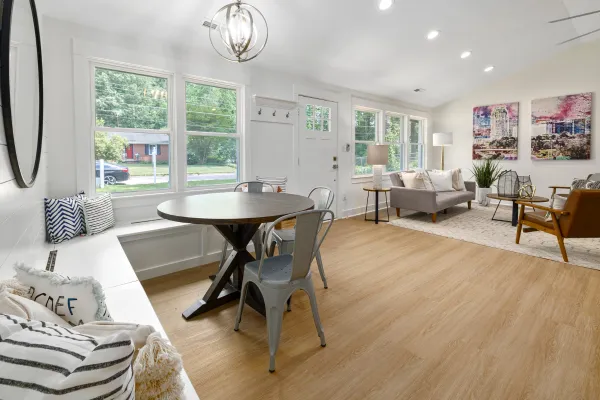

Creating an Autism-Friendly Home Environment: Practical Insights and Empathetic Guidance
Creating an autism-friendly home begins with a foundational understanding of autism and the unique sensory sensitivities that people with Autism Spectrum Disorder (ASD) may experience.
Autism Spectrum Disorder (ASD) is a developmental condition that affects how individuals perceive, communicate, and interact with the world around them. While autism manifests differently in each person, common characteristics include challenges with social communication, repetitive behaviors, and unique ways of processing sensory information. It is important to recognize that autism is a spectrum, meaning that autistic individuals experience it in diverse ways, with varying strengths and challenges.
Some people may excel in specific areas, such as mathematics, art, or memory, while facing difficulties in other areas like communication or managing sensory inputs. This diversity reiterates the importance of creating environments and approaches based on the individual’s needs rather than applying a one-size-fits-all solution.
Key characteristics of autism include:
Communication differences – Challenges with verbal and nonverbal communication, ranging from limited speech to advanced verbal skills but with difficulties in social setting.
Repetitive behaviors – Engaging in repetitive movements or activities, such as rocking, lining up objects, or repeating phrases.
Preference for routines – A strong reliance on predictable schedules and routines to reduce anxiety.
Sensory sensitivities – Heightened or reduced sensitivity to sensory stimuli, such as light, sound, textures, or smells.
Sensory Processing and Autism
A core aspect of autism is the way individuals process sensory information. Sensory processing refers to how the brain interprets and responds to sensory inputs from the environment, including sight, sound, touch, taste, and smell. For many autistic individuals, sensory processing can be abnormal, leading to heightened sensitivity (hypersensitivity) or reduced sensitivity (hyposensitivity) to stimuli.
Hypersensitivity
Individuals who are hypersensitive may find everyday stimuli overwhelming or distressing. For example:
Bright lights or fluorescent bulbs may cause discomfort or headaches.
Loud or unexpected sounds, like a vacuum cleaner or doorbell, may trigger anxiety.
Certain textures, such as scratchy fabrics or sticky substances, may feel unbearable.
Hyposensitivity
On the other hand, those who are hyposensitive may seek out additional sensory input to feel balanced or focused. Examples include:
Enjoying bright or flashing lights.
Seeking physical sensations, such as deep pressure or tight hugs.
Not noticing sensations like cold, heat, or pain as readily as others might.
These sensory differences can significantly impact how an autistic person experiences their home environment.
Benefits of an Autism-Friendly Home
An autism-friendly home is a supportive and nurturing environment that meets the sensory, emotional, and practical needs of those with autism. This type of environment offers numerous benefits for both the individual and their family, including:
1. Improved Comfort and Safety
Creating spaces that minimize sensory triggers and provide safe areas for relaxation can reduce anxiety and promote a sense of security. For instance, installing soft lighting and noise-canceling curtains can create a calming atmosphere, while a designated “safe zone” can serve as a retreat during moments of sensory overload.
2. Enhanced Independence
By organizing the home in a way that is accessible and intuitive, autistic people can enjoy their surroundings more independently. Visual cues, labeled storage, and clearly defined activity zones can help promote self-reliance.
3. Better Emotional Regulation
An environment that accommodates sensory needs can help autistic individuals manage their emotions more effectively. For example, a sensory-friendly room equipped with tools like weighted blankets or noise-canceling headphones can provide a calming space to self-regulate.
4. Strengthened Family Relationships
When a home is designed with empathy and collaboration, it creates an inclusive atmosphere that benefits the entire family. By addressing the needs of the family member with autism, caregivers and members of the household can reduce stress and enhance overall harmony in the home.
Adapting Living Spaces
The way a living space is arranged can have a significant impact on the comfort and functionality of the environment for individuals with autism. Thoughtful adjustments can transform a home into a sanctuary that feels safe and welcoming.
Decluttering and Organization
Why it matters: Clutter can be visually overstimulating and cause anxiety for individuals with autism.
Solutions:
Minimize unnecessary items and maintain a clean, orderly space.
Use storage solutions like bins, shelves, and cabinets to keep belongings out of sight.
Label storage areas with words or pictures to enhance accessibility and reduce frustration.
Visual Boundaries and Zoning
Why it matters: Clearly defined spaces help individuals understand where activities occur, creating predictability and reducing confusion.
Solutions:
Use rugs, furniture arrangements, or room dividers to designate activity zones (e.g., play, relaxation, study).
Apply color-coding or visual markers to signify different areas of the home.
Lighting and Colors
Lighting and color schemes can significantly affect sensory experiences. Harsh lighting or overly vibrant colors may overwhelm autistic family members, while softer tones and natural light can have a calming effect.
Lighting Tips
Natural Light – Maximize the use of natural light by keeping windows unobstructed and using sheer curtains. Natural light promotes a sense of calm and connection to the outdoors.
Dimmer Switches – Install dimmer switches to adjust the brightness of artificial lighting based on individual preferences.
Avoid Fluorescent Lights – Replace fluorescent bulbs with LED or incandescent lighting to reduce flickering and harshness.
Sensory-Friendly Lamps – Use lamps with adjustable brightness to create a soothing atmosphere.
Choosing Colors
Opt for neutral or pastel colors, such as soft blues, greens, or beiges, to create a calming ambiance.
Avoid overly bright or clashing colors, as they may be visually overstimulating.
Use accent colors sparingly to add personality without overwhelming the senses.
Noise and Acoustics
Excessive noise or unpredictable sounds can be distressing for autistic individuals. Managing acoustics in your home is essential for creating a peaceful environment.
Noise-Reducing Strategies
Soft Furnishings – Use rugs, curtains, and cushions to absorb sound and reduce echo.
Noise-Canceling Curtains – Invest in thick curtains to block out external noises, such as traffic or neighbors.
Quiet Zones – Designate specific areas of the home as quiet zones where individuals can retreat during sensory overload.
Technology Solutions
Noise-Canceling Headphones – Provide access to headphones to help block out distressing sounds.
White Noise Machines – Use white noise machines or apps to mask background noise and promote relaxation.
Designing a sensory-friendly home involves thoughtful adjustments. But also remember, every individual with autism is unique, so what works for one may not work for another.
ABOUT US

Jeanne Prinzivalli
Therapist + Coach
I help ambitious, anxious women learn how to trust and put themselves first, so they can stop burning themselves out trying to meet other people's expectations.
SELF CARE CONTINUUM
CLIENT LINKS
LET'S CONNECT
Let’s get you started on relief from self-sabotaging patterns so you can move forward with your life and career passions.
Self Care Continuum Copyright © 2023.




